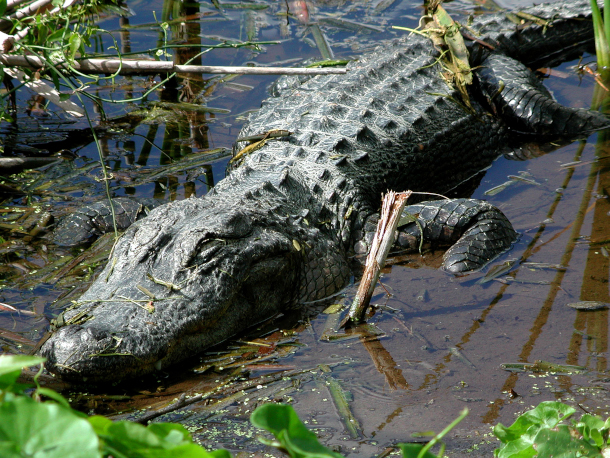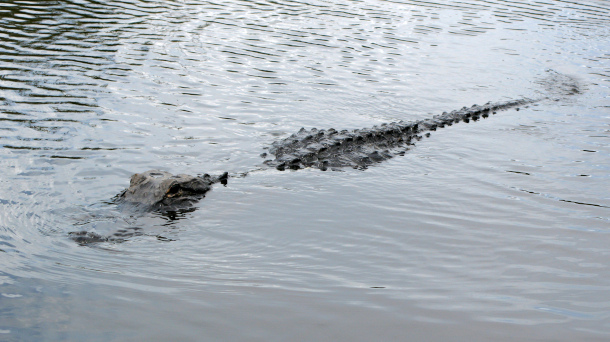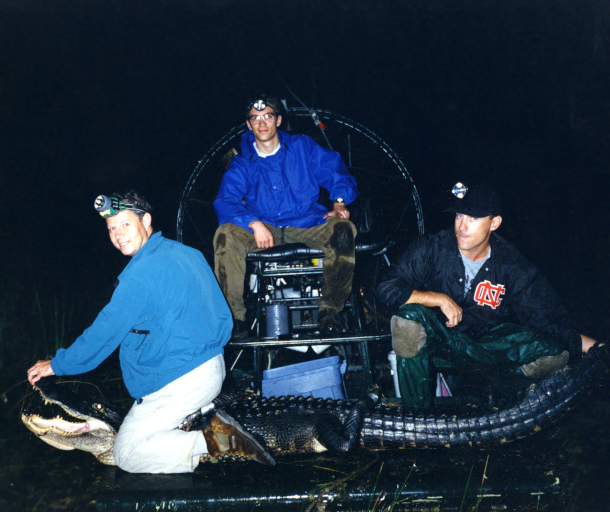Midnight in the Everglades
Air Date: Week of January 6, 2023

An alligator in Everglades National Park. (Photo: Sheila Sund, Flickr, CC BY-NC 2.0)
Alligators have such gaping jaws you might wonder what they eat. For one group of researchers looking into this, the answers so far point to snails and amphibians like the giant salamanders known as amphiumas, rather than fish or hapless mammals that walk too close to swampy waters. Living on Earth’s Don Lyman spent a night in Florida’s Everglades with a team investigating this and shares his story.
Transcript
DOERING: Alligators have such gaping jaws you might wonder what they eat. For one group of researchers looking into this the answers so far point to snails and amphibians like the giant salamanders known as amphiumas rather than fish or hapless mamals that walk too close to swampy waters. Living on Earth’s Don Lyman spent a night in Florida’s Everglades with a team investigating this and shares his story with us.
[MUSIC: Blue Dot Sessions, “Distill,” Darby, Blue Dot Sessions 2021]
LYMAN: We ply the darkness in a noisy airboat, my friend Brady in the pilot’s seat, spotlighting for alligators. The flat hulled craft is made for this environment, and we move easily through thick patches of four-foot-tall sawgrass and shallow water that ranges in depth from a few inches to a few feet. The breeze from the moving boat makes the 70-degree early evening air feel cooler than it actually is.
Brady is a graduate student, studying alligator diets in Everglades National Park for his Ph.D. dissertation. He has spent the past few years catching gators and pumping their stomachs to analyze what they are feeding on — research that could prove important in helping to conserve the iconic reptiles.
"There's one up ahead!" Brady shouts over the roar of the engine. Don, his undergraduate assistant, stands at the bow of the boat holding a gator noose, which consists of a long aluminum pole with a wire noose attached to about 30 feet of rope.
The reptile's eyes glow orange in the beam of the spotlight as it floats motionless in the water ahead. As we get closer it begins to swim away along the surface. Brady explains that alligators spook easily in daylight, quickly diving out of sight, but for some reason at night they don't, making them easier to capture, which is why gator researchers often work the graveyard shift.
[MUSIC: Blue Dot Sessions, “Flashing Runner,” Resolute, Blue Dot Sessions 2017]
LYMAN: Don steadies himself as Brady maneuvers the boat closer to the swimming animal. He reaches out with the noose and tries to slip the loop of wire over the gator's head, but misses.
"Get him!" Brady barks.
"I'm trying!" Don shoots back.
When we get close, Don tries again, but again he misses.
“Just get it on him!” Brady yells.
On his third attempt Don lassoes the gator, which dives under water with a splash of its thick, powerful tail.
It pulls on the line, occasionally surfacing near the boat, thrashing wildly.
[MUSIC: Blue Dot Sessions, “Flashing Runner,” Resolute, Blue Dot Sessions 2017]
LYMAN: After about 10 minutes the gator begins to tire, and Don slowly pulls the line in. Brady cuts the engine, comes down onto the deck, and lies down on his stomach to be in position to grab the gator, but quickly decides he’s too vulnerable.
“Let me get on my elbows,” he says. “I can’t go anywhere if the gator tries to get me.”

A twelve-foot alligator pokes its head above the surface of the water. (Photo: djmcaleese, Flickr, CC BY-NC-ND 2.0)
Brady asks me to duck tape the gator’s jaws shut, so I join him on the deck with a roll of duct tape, nervously crouching on my knees, my heart pounding. Don maneuvers the line so the gator's head is above water and tight against the bow. Brady grabs the gator's jaws and holds them shut while I duct tape around the animal’s snout as fast as I can, with Brady yelling "Hustle! Hustle! Hustle!"
[MUSIC: Blue Dot Sessions, “Flashing Runner,” Resolute, Blue Dot Sessions 2017]
LYMAN: When the duct taping is through, Brady releases his grip, Don lets up on the line, and the gator disappears beneath the surface in an explosion of water.
After several minutes Don once again pulls the exhausted animal toward the boat. He and Brady step off the edge of the bow into the knee-deep water and wrestle the big black reptile onto the deck. Don lies on top of the gator with his hand over its eyes to keep it still while Brady duct tapes the animal’s feet together behind its back so it can’t move around.
[MUSIC: Blue Dot Sessions, “Plaster Combo,” Darby, Blue Dot Sessions 2021]
To pump the gator’s stomach, it has to be filled with water, which is done using a submersible pump attached to a section of garden hose. Brady removes the duct tape from the gator’s mouth, then gently taps the reptile on the snout with a section of PVC piping. The gator opens its mouth wide and lets out an angry hiss.
[MUSIC: Blue Dot Sessions, “Plaster Combo,” Darby, Blue Dot Sessions 2021]
Brady places the pipe lengthwise in the gator’s mouth, which causes it to clamp down hard on the PVC piping. He then wraps duct tape around the gator’s mouth again, so the plastic pipe won’t fall out.
The pump is placed in the water, the animal is rolled onto its back, and the end of the hose is lubricated and gently inserted down the alligator’s throat through the PVC pipe. Its stomach quickly fills with water when the pump is turned on.
I press down on the reptile’s distended stomach with both hands, like I’m performing CPR, causing the gator to regurgitate its stomach contents into a bucket, which we collect for processing back at the lab. We repeat this routine several times until nothing but water comes out.
[MUSIC: Blue Dot Sessions, “Plaster Combo,” Darby, Blue Dot Sessions 2021]
LYMAN: Brady told us one time he was pumping the stomach of a big gator and a live three-foot-long amphiuma — a large, aquatic eel-like salamander — rocketed out of the gator’s mouth and latched onto Brady’s arm, giving him a painful bite and scaring him half to death.
Fortunately, the gator we captured contained only a few clumps of scales from a water snake it had eaten.
“That’s a pretty Spartan diet,” Brady comments.
After measuring and tagging the animal, we untape its legs, and the 10-foot reptile calmly clambers over the side of the airboat into the water, and slowly swims away along the surface into the darkness.
Over the next several hours we catch a few more gators, and repeat the stomach pumping routine.

Don Lyman (left), Seth Lambiase (center) and Brady Barr (right) grab hold of an alligator on their airboat in Everglades National Park in November 1996. (Photo: Don Cramps, courtesy of Don Lyman)
Brady said that prior to his study it was thought alligators in south Florida ate mostly fish, but he had discovered that larger gators fed predominantly on snakes, amphiumas, and surprisingly, apple snails. In fact, snails were the major prey item for sub-adult alligators. Brady had found that big gators would occasionally feed on wading birds and mammals too. His research helped to analyze the complex interconnected food web that makes up alligators’ diets.
After tagging the last gator, we release it back into the water, then sit for a bit contemplating the night’s events.
[MUSIC: Blue Dot Sessions, “Distill,” Darby, Blue Dot Sessions 2021]
LYMAN: The adrenalin is still pumping as we excitedly recount our adventures.
“Did you see Don jump when that big gator attacked the airboat right under his feet?”
Brady says. Excited banter soon gives way to quiet reflection.
“It’s beautiful out here,” I say.
“It sure is,” Brady replies.
Moonlight illuminates our surroundings, and a gentle breeze blows in from the Gulf of Mexico, stirring the sawgrass. A red light blinks from the top of a radio tower in the distance, and lightning briefly flashes in small patches here and there on the horizon. Solitude envelops us.
[OWL SOUNDS]
DOERING: That’s Living on Earth’s Don Lyman.
Links
Living on Earth wants to hear from you!
Living on Earth
62 Calef Highway, Suite 212
Lee, NH 03861
Telephone: 617-287-4121
E-mail: comments@loe.org
Newsletter [Click here]
Donate to Living on Earth!
Living on Earth is an independent media program and relies entirely on contributions from listeners and institutions supporting public service. Please donate now to preserve an independent environmental voice.
NewsletterLiving on Earth offers a weekly delivery of the show's rundown to your mailbox. Sign up for our newsletter today!
 Sailors For The Sea: Be the change you want to sea.
Sailors For The Sea: Be the change you want to sea.
 The Grantham Foundation for the Protection of the Environment: Committed to protecting and improving the health of the global environment.
The Grantham Foundation for the Protection of the Environment: Committed to protecting and improving the health of the global environment.
 Contribute to Living on Earth and receive, as our gift to you, an archival print of one of Mark Seth Lender's extraordinary wildlife photographs. Follow the link to see Mark's current collection of photographs.
Contribute to Living on Earth and receive, as our gift to you, an archival print of one of Mark Seth Lender's extraordinary wildlife photographs. Follow the link to see Mark's current collection of photographs.
 Buy a signed copy of Mark Seth Lender's book Smeagull the Seagull & support Living on Earth
Buy a signed copy of Mark Seth Lender's book Smeagull the Seagull & support Living on Earth

